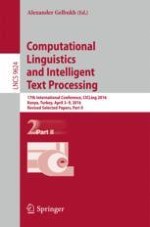2018 | OriginalPaper | Buchkapitel
Deeper Summarisation: The Second Time Around
An Overview and Some Practical Suggestions
verfasst von : Simone Teufel
Erschienen in: Computational Linguistics and Intelligent Text Processing
Aktivieren Sie unsere intelligente Suche, um passende Fachinhalte oder Patente zu finden.
Wählen Sie Textabschnitte aus um mit Künstlicher Intelligenz passenden Patente zu finden. powered by
Markieren Sie Textabschnitte, um KI-gestützt weitere passende Inhalte zu finden. powered by
